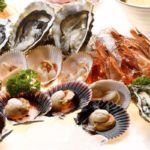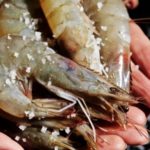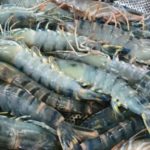Shrimp is a nutritious and delicious food, often favored by homemakers for family meals and special occasions. However, low-quality shrimp can be a disaster in terms of taste and health risks.
Bargain shrimp may be a bad deal:
Shrimp is a luxury food, but only when it’s fresh and safe. If you don’t know what to look for, you could end up buying stale, spoiled, or injected shrimp. These are the kinds of shrimp you should avoid, even if they’re cheap.
Shrimp with fillers:

Shrimp with fillers – don’t be tempted by cheap prices, as these shrimp are bad for your health. (Photo: Dan Viet)
Shrimp that feel stiff and unnaturally straight have likely been injected with fillers. Normally, shrimp should be flexible and curved.
Filled shrimp often have abnormally plump and bloated bodies, with their segments stretched, especially the one connecting the head and body. Their gills are stiff and swollen, whereas natural shrimp gills are soft and flat.
When freshly dead, filled shrimp tend to have swollen heads, erect spines, and fanned tails. Their heads also detach easily from their bodies. When cooked, these shrimp release a lot of water, causing the meat to shrink and become blander than usual.
If the shrimp have been injected with agar, you’ll notice a layer of it between the meat and the shell, especially near the head and under the gills, once they’re peeled.
Shrimp with loose heads:
Healthy shrimp have slightly curved bodies and firm, taut flesh. Frozen shrimp tend to curl into a round shape, rather than remaining straight or slightly curved like fresh shrimp.
If the area where the head joins the body is black or loose, and the head is about to fall off, the shrimp is not fresh. Avoid buying these, even if they’re cheap.
Look for shrimp with intact shells and heads firmly attached to the body, ensuring they’re fresh.
Unusual color:
Fresh shrimp have bright colors and a pleasant sea scent. Dull, grayish shrimp with an unpleasant odor are likely stale and should be avoided, even if they’re cheap.
How to choose fresh shrimp:
Fresh shrimp should have the following characteristics:

Choose shrimp with intact shells. Their heads and legs should be firmly attached to the body. (Photo: Grist.org)
Inspect the body and head:
Fresh shrimp have slightly curved bodies and firm, taut flesh. They might not be the largest, and their meat won’t be unusually thick.
Look for shrimp with intact shells. Their heads and legs should be firmly attached to the body. Fresh shrimp have glossy, smooth shells, and the area between the segments should be translucent.
Avoid shrimp with black legs, as this indicates spoilage.
Examine the tail:
Check the tail to determine the shrimp’s freshness. Fresh shrimp have tails that are folded and curved downward. Fanned tails suggest the shrimp have been injected with chemicals or water to make them look plumper. When cooked, these shrimp release a lot of water, causing the meat to shrink and become blander.
How to store fresh shrimp:
Many people like to stock up on shrimp and store them in the fridge. However, this can lead to blackened heads when they’re taken out for cooking. To avoid this, buy fresh shrimp, cut off their beards, and rinse them thoroughly before storing.
After rinsing, pat the shrimp dry and place them in a food container. Sprinkle a little white sugar over them, shake well, and store in the freezer or deep freezer at low temperatures.
The sugar will prevent the shrimp’s heads from blackening and keep them from sticking together. You can easily take out as many shrimp as you need without defrosting the entire batch.
Don’t store shrimp for too long (ideally less than 30 days) to maintain their nutritional value and taste.
According to VTC News
How to Choose Fresh Seafood: Important Cabinet Tips
In recent years, concerns have been raised over the practice of injecting urea and chemicals into seafood, making it difficult to find safe and fresh options. To help, DienmayXANH.com offers some tips on how to select the best seafood available. Seafood is a rich, delicious, and nutritious source of food, and this advice will help ensure you make the most of it.




































